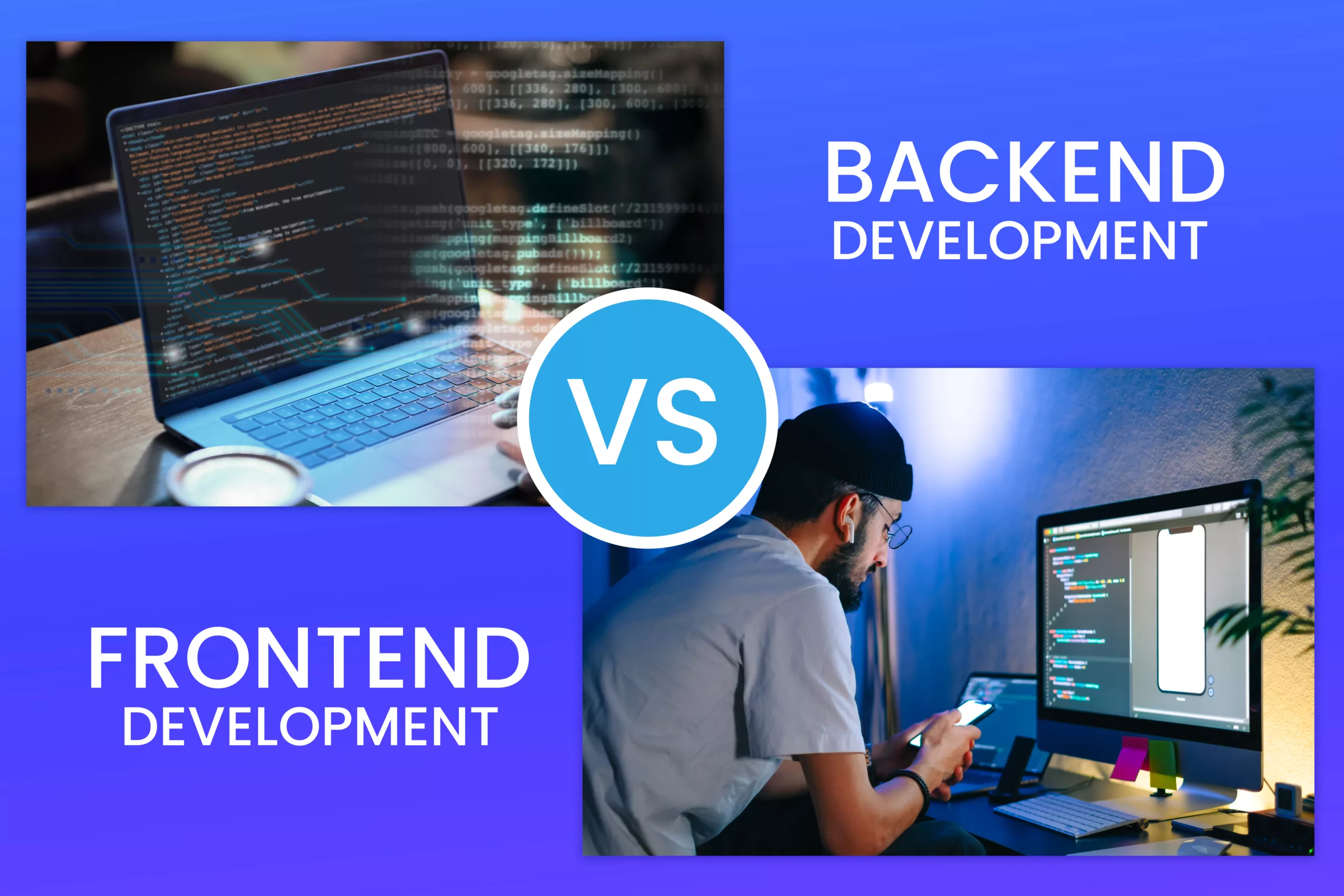Have you ever been curious about the process of how websites and apps work and how they leverage and send data to users? If you have, then you’re interested in the workings of backend development.
Backend development is a type of web or app development that works in the background, which the user cannot see. It involves the process of the web application’s logic, features, and functionality.
By the end of this blog, you’ll know the fundamentals of backend development, the differences between frontend and backend development, and how to get started with backend development.
Let’s dive in.
Backend development: What is it?
Backend development is the process of developing and maintaining the website’s server-side applications. The functionality of the backend development is invisible to the users. That includes authentication, authorization, encryption, caching, and logging.
A backend system’s primary components are:
Databases
It’s a group of organized data that leverages a specific programming language to be searched and manipulated. The database stores and manages the user’s data, which can be easily arranged and recovered. The database runs on a dedicated server that offers data whenever required. Some of the popular types of databases are MongoDB and MySQL.
Servers
A server is a computer or a program that provides information or data upon request. The primary function of a server is to host the web application and offer all the resources for it to function optimally. Servers run on different platforms and leverage different technologies, including Apache, Microsoft IIS, and Python.
APIs (Application Programming Interface)
An API is a set of rules and regulations that specifies how to develop application software. APIs streamline the process of sending and receiving user data of servers in a consistent manner. APIs use a variety of formats and techniques, including RESTful APIs, GraphQL APIs, and SOAP APIs.
Frameworks
A framework is a collection of libraries that allows you to build the server configuration. They also offer a predefined structure to develop web applications. Frameworks are connected with programming languages, allowing programmers to write efficient code and follow the best practices. That enables them to make fewer coding mistakes. Frameworks are specific to a programming language or platform—for instance, Django for Python, Rails for Ruby, and Laravel for PHP.
What Is The Difference Between Frontend And Backend Web Development?

To develop a functional and engaging website, backend development and frontend development must cooperate.
Frontend refers to the “client-side” of the web application. It manages the coding and development of elements of a website that the user sees. Frontend development ensures that the visual aspects of the website are functional optimally. The primary responsibility of a front-end developer is to code and breathe life into the static visual elements of a website. Their role is to make the website aesthetically pleasing and intuitive while also running smoothly.
The front-end developers take the designs from UI/UX designers and leverage programming languages like HTML, CSS, and JavaScript to develop graphical user interfaces of a website. It ensures that the website functions optimally for the users. Furthermore, front-end development allows you to build static websites. It’s a website that stores the exact data in its database and displays it to the user’s browser. For instance, you might land on a small business website where you won’t be able to perform any interactive tasks.
Backend development refers to the “server side” of the web application, managing the website’s functionality and logic. The function and working environment of backend development happens behind the scenes, which the users cannot see. Backend developers leverage programming languages such as PHP, Ruby, or Java to write codes to communicate with servers and databases.
For instance, you have a social media website, and you need an accessible place to store all your users’ data. That dedicated place for storing data or information is called a database. Some of the popular databases include MySQL, Oracle, and SQL Server. The server is mostly a remote computer which is used to run a database. A backend developer will organize and manage this database along with the stored site content. This ensures that the visual elements of the front end of your website seamlessly function optimally.
The primary distinction between frontend and backend development is that the former focuses on its outward appearance and user experience, whereas the latter focuses on the intangible structure. Both are necessary for building a successful web application that fulfills user requirements and expectations.
Why Is Backend Development So Important?

Backend development is very important because it forms the basis of any website and web application. The front end, which users see and interact with, would not be able to store, process, and distribute data without backend development. A website’s or web application’s functionality, performance, and security are also provided by backend development.
Backend development is crucial for the following reasons, among others:
Enables User Interaction
Backend development provides user engagement by enabling operations like logging in, signing up, leaving comments, sharing files, making payments, etc. on a website or online application. The backend must validate, process, and store user data for these operations in addition to generating valid answers.
Provides Data Access
Backend development allows data access to users from multiple sources. That includes databases, APIs, and web services. The backend development queries and retrieves data from these sources and delivers it to the front end in a format that is easily displayed and understood by the users for manipulation.
Guarantees Security
Backend development guards against unauthorized access, cyberattacks, or data breaches for the website or web application. To protect the data and the system from potential threats, the backend employs security features such as encryption, authentication, authorization, firewall, etc.
Boosts Performance
Backend development improves the performance of a website or web application by optimizing database and images, utilizing a content delivery network (CDN) and content management system (CMS), and leveraging browser caching. Furthermore, the backend monitors and analyzes the system performance and identifies and fixes any issues, such as broken links or redirects, that may compromise the user experience.
How To Get Started With Backend Development?

Embarking in the journey of backend development is exciting and challenging, whether you’re a beginner or transitioning from frontend development. Here’s how you can get started on backend development:
Select a Programming Language
A programming language is an essential tool that allows you to write code for website development. Only opt for one programming language at a time. Conduct a little research first. Each language has its own pros and cons. You should choose the one that fits the bill. The rule of thumb is to start with one programming language and then go for the next. One best practice is to start with PHP, as it’s one of the most powerful yet easiest programming languages for backend development.
Study The Fundamentals Of Web Development
Before you start working on backend, it’s paramount that you should have a basic know-how of web development and how it works. Understanding these concepts will help you have a better know-how of the job description of a backend developer. You will further understand how they collaborate with frontend, full-stack developers, and others involved in web development.
Learn a Framework
A framework is a library of tools of predefined components or solutions that are customized to expedite the development process. A framework provides a basic structure that doesn’t allow you to do much coding and easily follow the best practices. It helps avoid common mistakes and errors. Each framework is designated to a specific programming language. For example, Django for Python, Express for Node.js, Ruby for Rails, and Laravel for PHP. Since we already suggested learning the PHP framework, Laravel first.
Discover Databases
A database is like a vault that stores and retrieves data easily accessible and manipulated using a specific programming language. These data can be in the form of user profiles, postings, comments, or orders. It’s crucial for backend developers to be familiar with the databases, including MongoDB, MySQL, PostgreSQL, Redis, and OrientDB. Not only that, but you should also be able to design, model, query, and optimize databases for your web applications.
Understanding Web Servers
A web server is a computer program that receives, processes and answers client requests and queries with relevant information. The most common type of client is a web browser program, which sends data requests to your website. Java, PHP, Python, and Apache are some of the most popular web servers you should learn. You should also know the deployment, configuration, and administration of web servers to become a backend developer.
Build Projects
Build your project if you want to put your best foot forward in backend development. Come up with an innovative solution that addresses a particular problem. It’s a great way to put your knowledge and understanding of tools to the test. Not only that but also it creates a portfolio where you can showcase your skill set to potential clients or employers.
Hire Backend Developers For A Specific Project Through VinnCorp
Finally, if you’re interested in backend development, you should have some sort of degree in computer science or software engineering. It may be challenging, but it’s totally worth it.
Here are a few last things to remember:
- Not all backend development involves writing code. It also involves understanding the fundamentals of data modeling, security, and software architecture.
- Backend developers should be proactive in addressing problems and coming up with innovative solutions.
- The field of backend development is continually changing. Backend developers must be eager to learn new skills and adjust to emerging trends.
Is backend development a little too overwhelming? Fret not; get in touch with VinnCorp today. We resource Silicon Valley standard backend developers at an affordable cost that would realize your dream project.
Get a quote for backend development services today!



